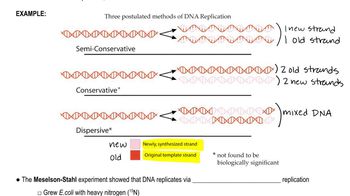While many commonly used antibiotics interfere with protein synthesis or cell wall formation, clorobiocin, one of several antibiotics in the aminocoumarin class, inhibits the activity of bacterial DNA gyrase. Similar drugs have been tested as treatments for human cancer. How might such drugs be effective against bacteria as well as cancer?
Table of contents
- 1. Introduction to Genetics51m
- 2. Mendel's Laws of Inheritance3h 37m
- 3. Extensions to Mendelian Inheritance2h 41m
- 4. Genetic Mapping and Linkage2h 28m
- 5. Genetics of Bacteria and Viruses1h 21m
- 6. Chromosomal Variation1h 48m
- 7. DNA and Chromosome Structure56m
- 8. DNA Replication1h 10m
- 9. Mitosis and Meiosis1h 34m
- 10. Transcription1h 0m
- 11. Translation58m
- 12. Gene Regulation in Prokaryotes1h 19m
- 13. Gene Regulation in Eukaryotes44m
- 14. Genetic Control of Development44m
- 15. Genomes and Genomics1h 50m
- 16. Transposable Elements47m
- 17. Mutation, Repair, and Recombination1h 6m
- 18. Molecular Genetic Tools19m
- 19. Cancer Genetics29m
- 20. Quantitative Genetics1h 26m
- 21. Population Genetics50m
- 22. Evolutionary Genetics29m
8. DNA Replication
Overview of DNA Replication
Problem 25
Textbook Question
How does rolling circle replication differ from bidirectional replication?
 Verified step by step guidance
Verified step by step guidance1
Understand the concept of rolling circle replication: Rolling circle replication is a mechanism of DNA replication commonly found in plasmids, viruses, and some bacterial genomes. It involves the continuous synthesis of a new strand of DNA while the template strand is displaced, forming a single-stranded DNA tail.
Understand the concept of bidirectional replication: Bidirectional replication occurs in most prokaryotic and eukaryotic chromosomes. It involves the initiation of replication at a specific origin, followed by the simultaneous synthesis of new DNA strands in opposite directions, creating two replication forks.
Compare the initiation process: In rolling circle replication, replication begins with a nick in one strand of the circular DNA, exposing a 3' hydroxyl group for DNA polymerase to extend. In bidirectional replication, replication begins at a specific origin of replication, where the DNA strands are unwound to form a replication bubble.
Compare the direction of replication: Rolling circle replication proceeds unidirectionally, with the new strand being synthesized continuously around the circular template. In contrast, bidirectional replication involves two replication forks moving in opposite directions from the origin, synthesizing DNA on both strands simultaneously.
Compare the end products: Rolling circle replication produces a long single-stranded DNA tail that can be converted into double-stranded DNA or used directly, depending on the organism. Bidirectional replication results in two identical double-stranded DNA molecules, each containing one parental strand and one newly synthesized strand.
 Verified video answer for a similar problem:
Verified video answer for a similar problem:This video solution was recommended by our tutors as helpful for the problem above
Video duration:
2mPlay a video:
Was this helpful?
Key Concepts
Here are the essential concepts you must grasp in order to answer the question correctly.
Rolling Circle Replication
Rolling circle replication is a mechanism of DNA replication primarily observed in certain viruses and plasmids. In this process, a circular DNA molecule is nicked, allowing one strand to unwind and serve as a template for continuous synthesis of a new strand. This results in the formation of multiple copies of the circular DNA, often leading to the production of long concatemeric DNA molecules.
Recommended video:
Guided course

Semiconservative Replication
Bidirectional Replication
Bidirectional replication is a common method of DNA replication in which the replication process occurs simultaneously in two directions from a single origin of replication. This results in the formation of two replication forks that move away from each other, allowing for the efficient synthesis of both strands of the DNA helix. This method is typical in prokaryotic and eukaryotic cells, ensuring rapid duplication of genetic material.
Recommended video:
Guided course

Semiconservative Replication
Comparison of Replication Mechanisms
The key difference between rolling circle and bidirectional replication lies in their mechanisms and outcomes. Rolling circle replication is unidirectional and produces multiple copies of a circular DNA molecule, while bidirectional replication is a more conventional approach that synthesizes linear DNA strands from a single origin. Understanding these differences is crucial for grasping how various organisms and viruses replicate their genetic material.
Recommended video:
Guided course

Semiconservative Replication
Related Videos
Related Practice
Textbook Question
529
views


